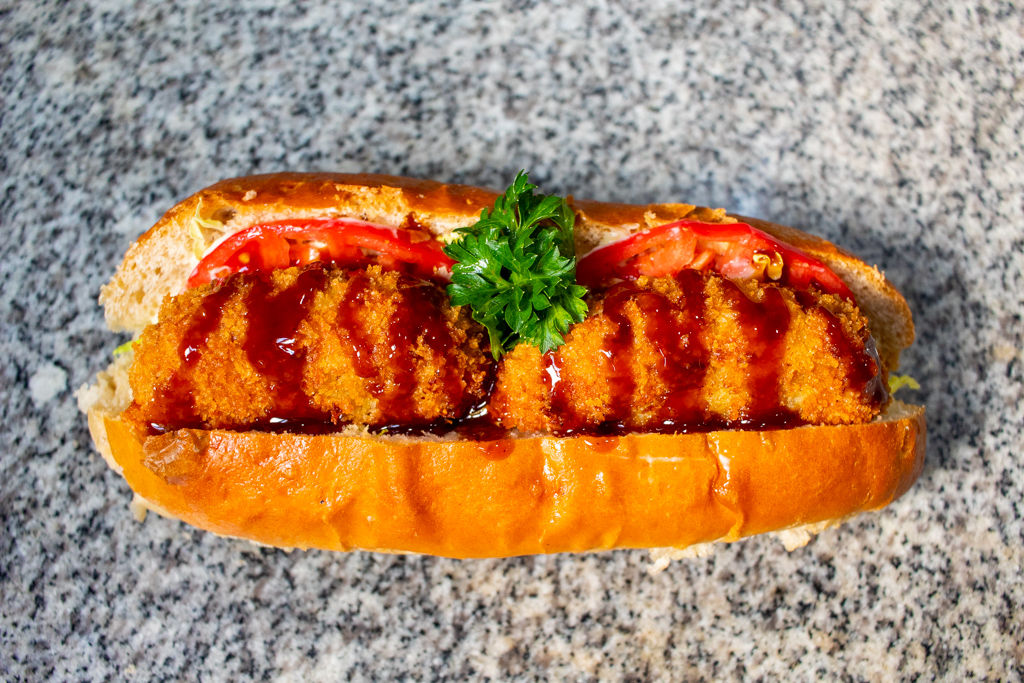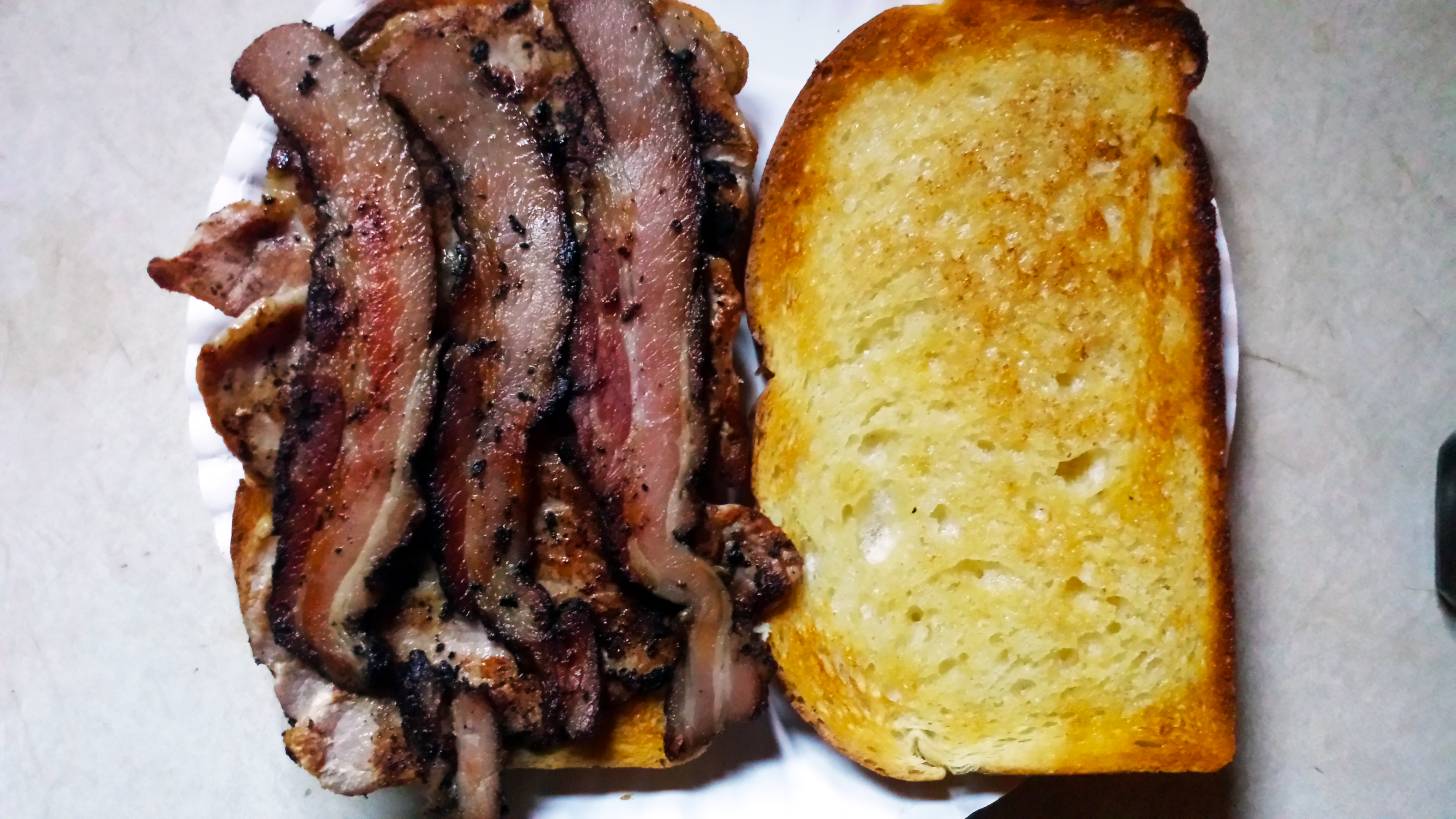Japanese Korokke Pan, or Croquette Sandwich
From the year 1639 until the latter half of the 19th Century, Japan practiced an isolationist foreign policy called Sakoku, in which there was only very limited contact and trade with external influences–Korea and China, mostly, with the only European influence coming from a Dutch factory churning out trade goods and Western gossip. The declaration of Sakoku followed nearly a century of trade with Portugal, and was instituted specifically to end the missionary influence of Portuguese Christians, in the belief it would, sooner or later, undermine the shogunate.
Several Portuguese words entered the Japanese lexicon before the Portuguese were ejected from Japanese shores, however. Perhaps among the better known is tempura, which came to be the Japanese name for a Portuguese dish of lightly battered and fried green beans served during the quarterly periods (or quatuor tempora in Latin) of meatless fasting observed by the Portuguese Christians (and eventually for battered and fried just-about-anything). More germaine to our discussion today, though, is the Japanese word pan which, like the word pav in multiple Indian languages, is derived from the Portuguese pão or bread.
It wasn’t until hundreds of years later, after their period of isolation ended, that the other half of the name of today’s sandwich was absorbed into the Japanese language. Korokke is the Japanese form of the French word croquette, which describes a snack made from a filling such as meat or fish, bound together with a thickened sauce, formed into cylinders, breaded, and deep-fried. So “Korokke Pan” essentially means “croquette bread,” which may sound familiar to long-time readers of the site. In fact, there is a very similar Dutch sandwich called Broodje Kroket that we covered early in the Tribunal’s run.
Japanese korokke do differ from the French version though. Whereas the French croquettes that the Japanese wanted to emulate were generally bound with a bechamel sauce–essentially a cream gravy–Japan in the late 1800s didn’t have much in the way of a dairy industry to supply the required milk. Instead, Japanese korokke are traditionally made with mashed potatoes, mixed with meat or vegetables. Korokke made with seafood and cream sauce are common in Japan now, but are also not used in Korokke Pan.
Korokke Pan, or korokke sando consist of traditional Japanese korokke–potato, or meat and potato, or potato and vegetable–in a long thin bread roll much like a hot dog bun, with shredded cabbage, some combination of sauces likely to contain Japanese Worcestershire and/or Tonkatsu sauce, and is garnished with a sprig of parsley. They are sold in prepackaged form at Japanese conbini, convenience stores like 7-11, which I am told have a much tastier food selection than the 7-11s around here.
I pick them up from time to time when making my roughly semi-annual shopping trip to Mitsuwa Marketplace in Arlington Heights, the largest Japanese grocery in the area. Their in-store bakery, Pastry House Hippo, generally has prepackaged furutsu sando, katsu sando, yakisoba pan, and korokke pan sitting out for purchase.

Whenever we visit Mitsuwa, we also pop in around the corner to a smaller Japanese bakery called Bakery Crescent, which sells a stunningly good coffee-glazed sweet roll that Mindy can’t get enough of. Crescent also sells a Korokke Pan, though in this case it’s less a sandwich and more of a croquette-stuffed bread roll.

Both of these contain korokke made up largely of smooth mashed potatoes, punctuated by the occasional pea or corn kernel. The Pastry House Hippo version adds a thin drizzle of Worcestershire sauce and some finely shredded cabbage, while the Crescent version goes a little heavier on the Worcestershire and garnishes with parsley.


These were fine. A bite of each and I’d had enough though. If I had to pick a favorite, I’d choose the version from Crescent due to a slightly better bread and its more aggressive seasoning, but I wasn’t terribly excited about either.
The most interesting thing about a korokke or croquette, to my mind, is the crunch. That is in fact what the word means in French–like the Croque Monsieur, it derives from the French verb croquer meaning “to crunch.” But when you premake a sandwich, mummify it in saran wrap and leave it to steam for a few hours before someone eats it, it’s not likely to have any crunch left to it. Maybe they’d be better if they were freshly made.
So of course I had to make my own.
Koppepan
As I’ve discovered previously when I’ve tried to buy these Japanese hot dog buns from Pastry House Hippo and Bakery Crescent, though they both sell sandwiches that use them, neither place sells the rolls themselves. It was up to me to make my own. I anticipated that these rolls would be made from a dough similar to that of Hokkaido milk bread or shokupan. I was corrected in this erroneous assumption though. I’ve mentioned my friend Sean previously, whose wife Junko is from Hokkaido originally. Junko identified the name of the Japanese hot dog bun–koppepan–and translated a small section of a Japanese Wikipedia page for me.
Invented by Genpei Tanabe, who developed the first bread making method using yeast in Japan, the shape of bread that has developed uniquely to Japan is the French “coupé (e)” bread and the United States. It is similar to the hot dog bun (English: hot dog bun) seen in, but Tanabe Genpei (Tanabe) who learned the bread making method in the United States at the end of the Meiji era and developed the bread making method by yeast for the first time in Japan in the Taisho era. This bread was devised by Genpei and developed uniquely to Japan.
I looked up recipes for koppepan and I found that the recipes I could find online were invariably quite similar, in fact almost identical to shokupan recipes, with the sole exception that they did not use the tangzhong or “water roux” technique. This technique involves cooking a small portion of the flour and water to be used in the recipe into a thick paste. It helps stabilize the bread and is said to give shokupan its uniquely fluffy, bouncy texture.
The recipe that I settled on did use the tangzhong technique and the buns turned out great.

Like the tall, fluffy loaves of milk bread, these buns hold their shape well, springing back from aggressive finger pokes and even being gripped with force. They are also quite soft, nicely browned due to the egg wash, and perfect for top-slicing and filling with any number of items.

Let’s waste them on some croquettes, shall we?
Korokke Pan, Round 1: Homemade
Mitsuwa sells frozen korokke–in fact, that is the very reason I had stopped in this month–and I’m quite fond of the curry potato flavor. My limited experiences with commercial examples of korokke pan tells me that they are generally made with plain potato or potato-and-vegetable korokke. However, my research shows that a meat-and-potato version may be more popular in the sandwiches, and Junko agrees. Here is the recipe I used, though I substituted half of the ground beef with ground pork, and added both finely-diced mushrooms and minced carrots.

Junko described the ideal temperature for frying these as the temperature at which a wooden chopstick makes a “pokpok” sound when submerged in hot oil. Further inquiry resulted in the slightly more scientific answer of 160° Celsius, or 320° Fahrenheit. I fried the korokke in a cast iron pan full of peanut oil on the side burner of my propane grill, which struggled to achieve an oil temperature of 325° F but did the trick.

In fact, I think they turned out quite well. Crisp and nicely golden brown on the outside…

Soft and potato-ey on the inside, studded with small beef and pork mince, the bright dots of carrot, the darker shadows of the mushrooms.

The korokke filling is only lightly seasoned with freshly ground black pepper, white pepper powder, and a bit of kosher salt, so while there is a lot of good flavor inside, it could be overwhelmed when the korokke is enclosed in a big fluffy hot dog bun. That’s where these come in.

From left to right, we have: Bull-Dog brand tonkatsu sauce, a thick dark sauce akin to a sweeter, smoother A1 that is often used with breaded fried pork in Japan; Kewpie mayonnaise in its signature squeeze bottle and babydoll wrapper, the quintessential Japanese mayo; a Japanese mustard paste so evil that its name dare not be uttered here, a sinus-chemical-burn-in-waiting; and Bull-Dog brand Japanese Worcestershire sauce, which a hastily-arranged head-to-head tasting against Ye Olde Lea & Perrins reveals to be slightly less sour but saltier than the classic English sauce, with a greater presence of warming spices.

For my first try at the Korokke pan, I put a thick squiggly trail of Kewpie mayo–which to be fair is difficult to aim effectively in its floppy plastic container–down the middle of the split-top bun, and scattered some finely shredded napa cabbage on top before adding some tonkatsu sauce.

Atop the cabbage, I placed the two halves of a korroke split lengthwise.

There was not much to this sandwich, to be honest. As I’d feared, the mild korokke flavor gets a bit lost in that big fluffy bun, mayonnaise and tonkatsu sauce notwithstanding. The cabbage is a nice textural counterpoint but overall, this is not going make any all-time greatest Sandwich Tribunal lists.
Korokke Pan, Round 2: Store Bought
I tried again with some of the other korokke I’d bought at Mitsuwa. First, and most highly anticipated, the reason I’d bought the hot Japanese mustard paste to begin with, was something that may not be considered a proper korokke at all, though it is often mentioned alongside them: menchi-katsu. Katsu is a Japanese word meaning cutlet and generally refers to a piece of pork (tonkatsu) or chicken that has been breaded in panko and fried. Katsu Sando, or the pork cutlet sandwich, is one of the great Japanese sandwiches.

“Menchi” on the other hand means a mince. The Menchi-Katsu is a patty of minced meat–in this case pork–that is breaded with panko and deep-fried. Again, this may not count as a korokke but it seems to bear as much or more resemblance to one than to an actual cutlet. I dressed this sandwich with a bead of the Japanese mustard, plenty of Kewpie mayonnaise, and a wavy drizzle of Tonkatsu sauce on top.

These condiments approximate those on the Katsu Sando, though obviously in quite a different form. The menchi-katsu was again very mild, and I appreciated the presence of the tonkatsu sauce, which was as perfect an accompaniment for menchi-katsu as it is for tonkatsu. As was that intense mustard–no matter how thin the bead you use, it is too much. It is my new favorite thing and I’m not sharing it.

Another type of korokke I’d been looking forward to trying were the pumpkin korokke. This is not made from what we think of as a pumpkin at all but from Kabocha, a type of Japanese squash. The flavor is very much like our pumpkins though. I skipped the mustard for this sandwich and dressed it simply with mayonnaise and tonkatsu sauce.


This korokke had perhaps the strongest, most distinctive flavor of the bunch. The pumpkin stands out in a way that the potato doesn’t, and while I don’t know for sure whether this flavor of korokke is commonly used in a sandwich, the distinctive flavor makes it work better than some of the others had.


Finally, I tried the vegetable korokke. While the examples I’d had from the bakeries had visible pieces of pea or corn in them, this korokke appeared to be as smooth as a plain potato korokke. However, there was a definite vegetable flavor detectable–perhaps they were pureed into the mashed potatoes? Still, not a favorite.
Korokke Pan, the Final Round
I’d liked my own korokke better than any of the commercial examples, and with the additional practice I’d had making sandwiches since my first round, I set about making the best possible example I could with my homemade korokke–the recipe had made 20 of them, of which I still had 12 left in the freezer, unfried.
First off, the condimentation–the cabbage and mayo are good together, but could use a little help. I drizzled a little of the Japanese Worcestershire sauce on the cabbage as well, and that made an improvement.
Second, the beigeness of it all. Can we get a more colorful version? Well, the Pastry House Hippo version uses thin slices of tomatoes in addition to the cabbage and sauces, and nearly every depiction I’ve seen online includes a sprig of parsley as a garnish, so…

And this was an improvement, it was! The tomato of course added more than just color, a change of texture, a bit of sweetness, a bit of acid, a hint of umami. Worcestershire and Tonkatsu sauces are in themselves great sources of not only umami but also big spicy and sour flavors. The parsley–well it looked pretty. But everything else was firing on all cylinders.

I think, though, that korokke pan just isn’t the sandwich for me. I think part of it is textural. While there are plenty of interesting textures in this sandwich, the crunch of the breading and the cabbage, the chew of the koppepan’s crumb, I just want some more resistance when I’m biting through a sandwich than the soft squishy interior of a potato croquette can give me. That’s not a problem with the sandwich itself, it’s an incompatibility of expectations. Additionally, this sandwich falls into the category of carb-on-carb sandwiches that historically I have had problems enjoying. With very few exceptions, I am not a fan of the carb-on-carb sandwich.
There are millions of people in Japan who disagree with me though, so what do I know? I will leave this sandwich to those who enjoy it and move on to further sandwich adventures. There’s aways something else to try.

I like sandwiches.
I like a lot of other things too but sandwiches are pretty great











Hi! I personally love korokke pan! I really enjoyed your article and all the history you included 🙂